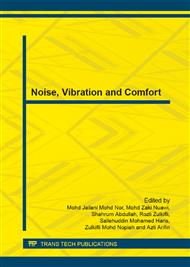[1]
PDRM, Laporan Tahunan PDRM (Royal Malaysia Police Annual Report). Royal Malaysia Police, Ed. Kuala Lumpur, Malaysia (2009).
Google Scholar
[2]
S.A.K. Ibrahim, R.S. Radin Umar, M. Habshah, H. Kassim, M. Stevenson, A. Hariza, Mode choice model for vulnerable motorcyclists in Malaysia, Traffic Injury Prevention 7 (2) (2006) 150–154.
DOI: 10.1080/15389580600550354
Google Scholar
[3]
H. Hussain, R.S. Radin Umar, M.S. Ahmad Farhan, M.M. Dadang, Key components of a motorcycle-traffic system — a study along the motorcycle path in Malaysia, IATSS Research 29 (1) (2005) 50–56.
DOI: 10.1016/s0386-1112(14)60118-7
Google Scholar
[4]
G, Jacobs, A, Aeron-Thomas, and A. Astrop, Estimating global road fatalities, TRL Report, 445, Transport Research Laboratory, London, United Kingdom (2009).
Google Scholar
[5]
N.T. Tran. Interventions for the Prevention of Road Traffic Injuries: Case Study of Malaysia. 2007. www. dcp2. org/file/233/malaysia%20case%20study_ntran_dec07. pdf.
Google Scholar
[6]
M. M Abdul Manan,. and A. Varhelyi, Motorcycle fatalities in Malaysia. IATSS Research. (2012). 36, 1, 30-39.
DOI: 10.1016/j.iatssr.2012.02.005
Google Scholar
[7]
S.S. Kee, S.B. Mohd Tamrin, Y.M. Goh. Driving Fatigue and Performance among Occupational Drivers in Simulated Prolonged Driving. Global Journal of Health Science. 2(1), (2010) 167-177.
DOI: 10.5539/gjhs.v2n1p167
Google Scholar
[8]
Ng, W. K and Selva, P. OSH Profile in the transport sector in particular commuting hazard. [Online] Available: http: /www. mtuc. org. my/osh_profile_transport. htm. (2003).
Google Scholar
[9]
C. D Meletis, and J. E. Barker. Herbs and Nutrients for the Mind: A Guide to Natural Brain Enhancers. Greenwood Publishing Group, Westport. (2004) 118.
Google Scholar
[10]
T. Ma, A. Williamson, R. Friswell. A pilot study of fatigue on motorcycle day trip. August (2003).
Google Scholar
[11]
F. M. Y, Muhammad, M., Norlen, O., Ilhamah, S. Rohayu, and S. V. Wong. (2008). Prevalence of fatigue among commercial bus drivers in Malaysia. Malaysian Institute of Road Safety Research. MRR 06/(2008).
Google Scholar
[12]
M., Norlen, F. M. Y, Muhammad,O. Ilhamah, S. Rohayu, and S. V. Wong. Fatigue among commercial bus drivers in Malaysia: Role of driving hours and single versus two-driver approach. Malaysian Institute of Road Safety Research. MRR 07/2008. (2008).
Google Scholar
[13]
S. Otmani, T. Pebayle, J. Roge and A. Muzet. Effect of driving duration and partial sleep deprivation on subsequent alertness and performance of car drivers. Physiology and Behaviour, 84 (2005). 715-724.
DOI: 10.1016/j.physbeh.2005.02.021
Google Scholar
[14]
P. Philip. Sleepiness of Occupational Drivers. Industrial Health, 43 (2005) 30-33.
Google Scholar
[15]
P., Philip, J. Taillard, E. Klein, P. Sagaspe, A. Charles, W. L. Davies, C. Guilleminault and B. Bioulac. Effect of fatigue on performance measured by a driving simulator in automobile drivers. Psychosomatic Research. 55 (2003) 197-200.
DOI: 10.1016/s0022-3999(02)00496-8
Google Scholar
[16]
A.F. Williams (1999) The Haddon matrix: its contribution to injury prevention and control. In McClure, Roderick (Ed. ) Third National Conference on Injury Prevention and Control, 9-12 May 1999, Brisbane, Queensland.
Google Scholar
[17]
N.L. Haworth, and P.J. Rowden, (2006) Investigation of fatigue related motorcycle crashes - literature review, Report to VicRoads.
Google Scholar
[18]
National Transportation Commission (2001). Options for a regulatory approach to fatigue in drivers of heavy vehicles in Australia and New Zealand.
Google Scholar
[19]
J. Granlund (2000). Whole-body vibration when riding on rough roads. Vagverket, road engineering division, 31E.
Google Scholar
[20]
M.J. Mohd Nor, M.H. Fouladi, H. Nahvi, A.K. A Mohd Ihsan. Index for vehicle acoustical comfort inside a passenger car. Applied Acoustics 69 (2008). 343–353.
DOI: 10.1016/j.apacoust.2006.11.001
Google Scholar


